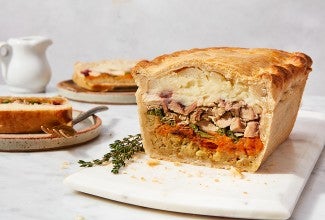-
To make the filling: Season the duck with 2 teaspoons salt and 1 teaspoon black pepper. In a 4- to 6-quart Dutch oven, heat the vegetable oil over medium-low heat and brown the duck legs, skin-side down, for 7 to 10 minutes. Do this slowly do that you render out as much fat as possible.
-
When nicely browned, flip the legs over and brown them on the other side. Remove them from the pan, pour off and reserve all but 1 tablespoon of the rendered fat, then add the onion, carrot, celery, garlic, and the remaining 1 teaspoon salt, and 1/2 teaspoon black pepper. Raise the heat to medium and cook, stirring occasionally, for about 15 minutes, until the vegetables begin to brown.
-
Once the vegetables are browned, add the wine. Bring to a boil and cook for 2 to 3 minutes. Stir in the stock, rutabagas, dates, herbs, bay leaves, star anise, and nutmeg.
-
Add the duck legs and any juices that accumulated while they were resting, and bring to a simmer. The liquid should come about 3/4 of the way up the sides of the duck legs; they shouldn't be submerged. Adjust the liquid level with stock or water if needed. Lower the heat, cover, and cook over medium-low heat for 1 hour at a brisk simmer.
-
After an hour, uncover and cook for 10 minutes more. Remove the pan from the heat and let the duck rest in the braising liquid for 20 minutes.
-
Transfer the duck to a plate. Once it's cool enough to handle, pull the meat off the bone in small, bite-sized pieces. Meanwhile, strain the braising liquid. Reserve the vegetables and discard the herbs and spices. Skim any fat you can from the top of the braising liquid. If you have time, chill the liquid so all the fat floats to the top, and scoop it off.
-
In a 10" cast-iron skillet, melt 2 tablespoons butter over medium heat until foaming. Whisk in the flour and cook for 1 to 2 minutes. Whisk in 2 1/2 cups of the reserved braising liquid, and bring to a boil. It should thicken and coat the back of a spoon. Stir in the reserved duck and vegetables.
-
To make the crust: Sift the flour, baking powder, and 1/2 teaspoon of the salt into the bottom of a large bowl and make a deep, wide well in the center. Add the duck fat followed by the buttermilk, taking care to keep both contained in the well for now. Using your fingers, rub the mixture together to make as much of a homogenous mixture as you can without incorporating too much of the flour.
-
Start moving the wet mixture back and forth in the flour with your fingers. Keep turning it over and introducing more flour with each movement. Try using a gentle motion like a one-handed knead, using your thumb as if it were on the other hand. Continue introducing flour until the dough is very soft and tender, but not sticky. You'll have about 2 tablespoons of flour left in the bowl. Lay a 10" square of parchment or waxed paper on the counter and turn the dough onto it. Form it into a ball and roll it 1/4" thick.
-
To assemble and bake: Preheat the oven to 375°F. Make sure the filling is warm. It doesn't need to be hot, but it shouldn't be cold, either.
-
Pick up the parchment by the edges and gently flip the pastry on top of the skillet. Trim the edges with a knife or crimp, as you like. Cut a 1" slit on top of the pastry and sprinkle with 1/4 teaspoon salt.
-
Put the skillet on a baking sheet, slide it onto the middle rack of your oven, and bake for 30 minutes. The crust should be golden brown, and the filling should have started to bubble up the sides. Serve warm.
-
Storage information: any leftovers in the refrigerator for several days; freeze for longer storage.


















